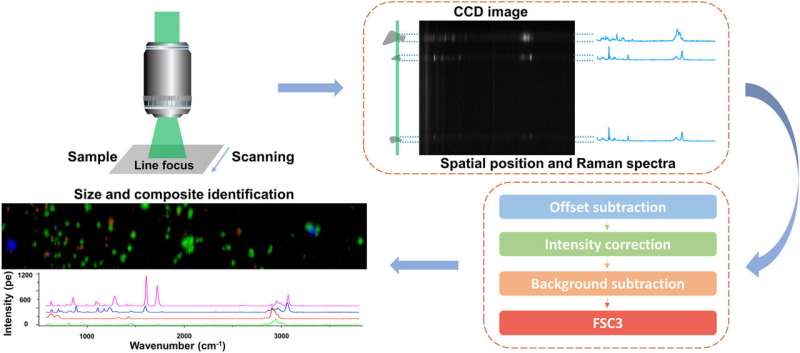This article has been reviewed according to Science X's editorial process and policies. Editors have highlighted the following attributes while ensuring the content's credibility:
fact-checked
trusted source
proofread
Line-scan Raman micro-spectroscopy provides rapid method for micro and nanoplastics detection

Microplastics—plastics particles smaller than 5 mm in size—have caused an environmental pollution issue that cannot be ignored by our society. Raman spectroscopy technology, with its non-contact, non-destructive and chemical-specific characteristics, has been widely applied in the field of microplastics detection. However, conventional point confocal Raman techniques are limited to single-point detection, impeding the detection speed.
In a study published in Talanta, a research group led by Prof. Li Bei from the Changchun Institute of Optics, Fine Mechanics and Physics (CIOMP) of the Chinese Academy of Sciences (CAS), in collaboration with Prof. Wolfgang Langbein from Cardiff University, proposed a novel line-scan Raman micro-spectroscopy technique for rapid identification of micro- and nanoplastics.
Based on the fundamental principles of confocal Raman spectroscopy, the focused excitation spot transforms from a convergent point into a convergent line with diffraction-limited width. The optical setup employs a conjugate imaging design. In the two-dimensional image recorded by the charge-coupled device (CCD), the vertical dimension maps the vertical dimension of the sample along the excitation line, while the spectrum is dispersed along the horizontal dimension. In this way, a single acquisition provides the spectra for all spatial positions along the excitation line.
Researchers developed a confocal line-scan Raman micro-spectroscopy system, established a preprocessing workflow for line-scan Raman spectral data, and applied the factorization into susceptibilities and concentrations (FSC3) algorithm to obtain Raman hyperspectral images. They employed a concave cylindrical lens to generate the excitation line and improved the uniformity of energy distribution using a Powell lens.
Plastic beads of various sizes were used for size and composition identification. The detection of beads with a diameter of 200 nm, which is smaller than the diffraction limit, was realized, demonstrating the exceptional sensitivity of the line-scan Raman spectroscopy system.
Furthermore, four types of plastic powder samples were used for a large-scale area of 1.2 mm in length and 40 μm in height measurement. Impressively, the imaging time is 20 minutes to obtain a 240,000-pixel Raman image. Compared with point confocal Raman imaging, the line-scan confocal Raman technology increases the imaging speed by two orders of magnitude.
Line-scan Raman micro-spectroscopy offers non-destructive analysis with high sensitivity and high-throughput. By employing appropriate sampling techniques such as filtration or sedimentation, environmental samples from various sources, including water, soil and air, are accessible.
More information: Qingyi Wu et al, Rapid identification of micro and nanoplastics by line scan Raman micro-spectroscopy, Talanta (2023). DOI: 10.1016/j.talanta.2023.125067
Provided by Chinese Academy of Sciences





















